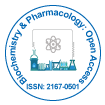
Biochemistry & Pharmacology: Open Access
Open Access
ISSN: 2167-0501

ISSN: 2167-0501
Srinivas Kantevari
Accepted Abstracts: Biochem & Pharmacol
Noscapine (a phthalide-isoquinoline), is an opium alkaloid, widely used as an antitussive agent with little evidence of toxicity. It was discovered as a structural variant of colchicine like molecule that binds to tubulin with a stoichiometry of one noscapine molecule per tubulin dimmer. However, unlike other tubulin binding chemotherapeutic agents that either depolymerise (nocodazole, colchicines, and vinca alkaloids) or over polymerize tubulin (paclitaxel), it just alters tubulin conformation upon binding yet allows its polymerization into microtubules (MTs) but merely suppresses the dynamic instability of microtubules. From a pharmacological perspective, noscapine has many advantages as microtubule binding drugs: it is effective against multidrug- resistant cancer cell line, affects cancer cells differently from the normal diving cells, and has better pharmacokinetics profile with no significant side effects. Although noscapine is cytotoxic in a variety of different cancer cell lines in the public library of the National Cancer Institute, USA (NCI 60-cell screen), and the IC50 values remain in the high micromolar ranges (~21.1 to 100 μM). Thus opportunities must now be explored to acquire better and more effective derivatives, noscapinoids. Indeed, our efforts have been quite encouraging, in that we have some more effective derivative of the lead compound, noscapine. Here, we discuss our results on design, synthesis and evaluation new noscapinoids as potent tubulin binding anticancer agents.
Srinivas Kantevari obtained his Ph.D. (1996) from Department of Chemistry, Indian Institute of Technology (IIT), New Delhi. He was research associate (1996-97) at National Institute of Immunology (NII) New Delhi. Later, he was a post-doctoral fellow (2001-2003) and research associate (2006-2008) with Prof. Graham Ellis-Davies, Department of Pharmacology and Physiology, Drexel University College of Medicine, Philadelphia, USA. He has been associated with Indian Institute of Chemical Technology (IICT) since 1997. Presently, he is sr. scientist at Indian Institute of Chemical Technology (IICT), Hyderabad. His research interests are broad based which include development of new photolabile compounds to control cellular chemistry, development new drug candidates and imaging agents for probing Alzheimer?s disease (AD), receptor targeted approaches for the development of new chemical entities, fragment based approaches for drug design and discovery. He has been able to successfully carry out extensive basic and applied research investigations in the chemistry of new molecules derived from natural products of biological relevance. Presently, 7 students are working for Ph.D. and 4 students for master?s dissertation work. He has 62 publications and 5 patents for his credit. He is an editorial board member for Open Journal of Catalysis, member, and editorial board of reviewers for ARKIVOC, and expert reviewer for various journals of international reputation. He also developed several processes for APIs and drug molecules of interest and involved in transferring the technologies.